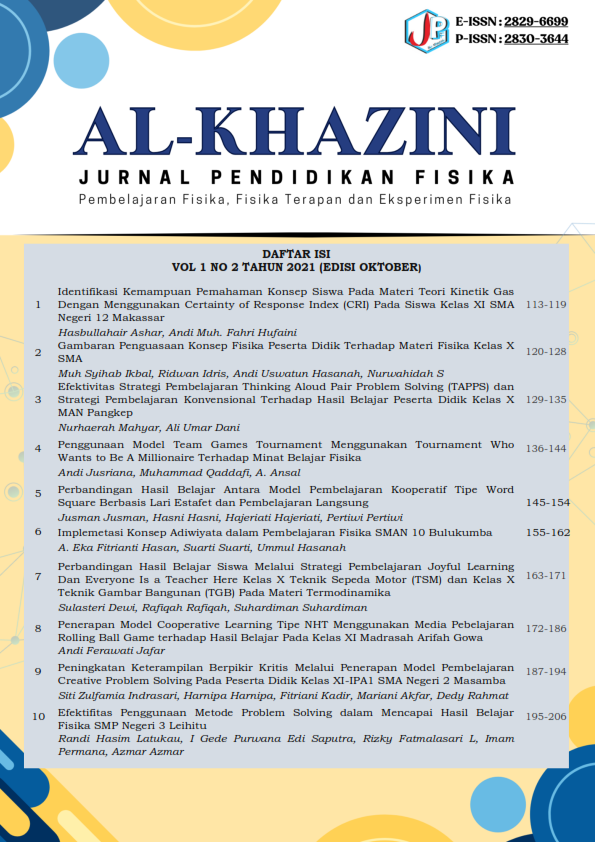Penerapan Model Cooperative Learning Tipe NHT Menggunakan Media Pebelajaran Rolling Ball Game terhadap Hasil Belajar Pada Kelas XI Madrasah Arifah Gowa
Abstract
This study aims to determine the learning outcomes of students using the NHT type cooperative learning model using rolling ball game learning media on learning outcomes in class XI Madrasah Arifah Gowa. The research method used is quasi-experimental with Noneequivalent control group design. The sample of this research is class XI.1 as many as 32 people and XI.2 as many as 27 people. Data collection is done by using a test of learning outcomes in the form of multiple choice questions. The statistical methodused descriptive analysis, inferential analysis, homogeneity test and hypothesis testing. Based on the results of calculations using the independent sample t-2 test using IBM SPSS v.20 obtained a value of 4.838 and the t table is sought by referring to the formula (α/2); (df) is equal to (0.05/2) ; (57). So that the value of the t table in the distribution of the t value of the statistical table is 2.002, thus the t-count value is 4.838 > t-table 2.002, so based on decision making through the comparison ofthe t-value with t-table, it can be concluded that H0 is rejected and H1 is accepted, which means there are differences in physics learning outcomes between the control and experimental classes or in other words the application of the lecture model with the NHT type cooperative learning model using the rolling ball game learning media will produce different physics learning outcomes. The implication of this research is that it is expected that educators can apply the NHT type cooperative learning model using rolling ball game learning media as an alternative in the teaching learning process to improve student learning outcomes.
Downloads
References
Dayuani, Rambe., dan Abdul, Hakim. 2012. Perbedaan Hasi Belajar Fisika Dengan Menggunakan Model Pembelajaran Kooperatif Tipe Nht Dan Model Konvensional Pada Materi Besaran Dan Satuan”Jurnal Pendidikan Fisika, Vol. 1 NO. 2. 8.
Faridah, A.S.2012 Pengaruh Model Kooperatif Tipe Nht Terhadap Hasil Belajar Siswa Kelas Viii Smp Negeri 18 Medan. Medan:Jurnal Pendidikan Fisika Vol. 1 No.1, 36-37.
Hery,Kresnadi., dkk. 2017.Peningkatan Hasil Belajar Siswa Menggunakan Metode Kerja Kelompok dalam Pembelajaran Ipa di Sekolah Dasar, 5.
Prof. Dr. Sugiyono.2019. Metode Penelitian Kuantitatif Kualitatif dan R&D. ALFABETA, cv,Edisi Kedua, Cetakan Ke-1 September, 131-135.
Sugiyono.2015. Metode Penelitian Kuantitatif, Kualitatif Dan R&D (Bandung: Alfabeta), 207.
S. Shopia, Sugisnto, Wiyanto. 2009. Pembiasaan Bekerja Ilmiah Pada Pembelajaran Sains Fisika Untuk Siswa Smp, Semarang: Jurnal pendikan Fisika Indonesia 5, 14
Widya Wati Dan Rini Fatimah. 2016. Effect Size Model Pembelajaran Kooperatif Tipe Numbered Heads Together (NHT) Terhadap Kemampuan Berpikir Kritis Siswa Pada Pembelajaran Fisika. Jurnal Ilmiah Pendidikan Fisika ‘Al-Biruni’ 05 (2). 214.
The Authors submitting a manuscript do so on the understanding that if accepted Al-Khazini:Jurnal Pendidikan Fisika for publication, copyright publishing of the article shall be assigned/transferred to Physics Education Department, UIN Alauddin Makassar as Publisher of the journal. Upon acceptance of an article, authors will be asked to complete a 'Copyright Transfer Agreement'. An e-mail will be sent to the corresponding author confirming receipt of the manuscript together with a 'Copyright Transfer Agreement' form by the online version of this agreement.
Al-Khazini:Jurnal Pendidikan Fisika and Physics Education Department, UIN Alauddin Makassar, , and Physics Society of Indonesia as the Editors and the Advisory International Editorial Board make every effort to ensure that no wrong or misleading data, opinions or statements be published in the journal. In any way, the contents of the articles and advertisements published in the Al-Khazini:Jurnal Pendidikan Fisika are the sole and exclusive responsibility of their respective authors and advertisers.
The copyright form should be signed electronically and send to the Editorial Office in the form of the original e-mail: [email protected]

